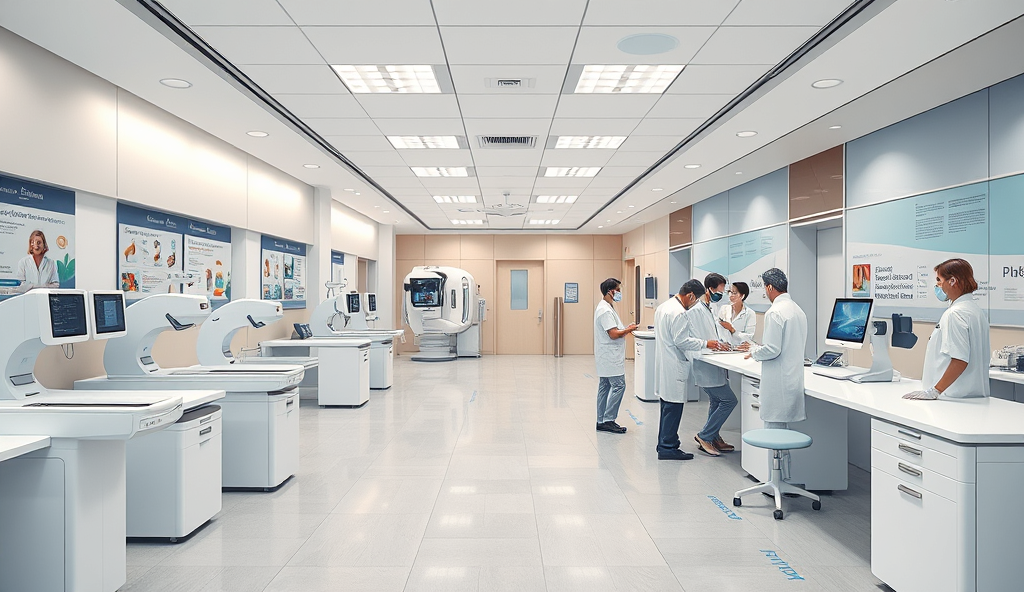Introduction to the Epe Health Masterplan in Nigeria
The Epe Health Masterplan represents a transformative initiative to address healthcare gaps in Lagos State’s Epe division, where only 32% of residents currently have access to quality medical facilities. Designed as a five-year framework, it aligns with Nigeria’s National Health Act and Lagos State’s health sector reforms to improve service delivery.
Key focus areas include upgrading primary healthcare centers and expanding specialist services, addressing critical shortages like the current 1:5,000 doctor-to-patient ratio in Epe. The masterplan also integrates community health workers into its strategy, recognizing their role in rural healthcare access.
By prioritizing infrastructure and workforce development, the Epe Health Masterplan lays the foundation for sustainable healthcare improvements. The next section will explore its core objectives and how they tackle Epe’s unique challenges.
Key Statistics

Overview of the Epe Health Masterplan Objectives
The Epe Health Masterplan represents a transformative initiative to address healthcare gaps in Lagos State’s Epe division where only 32% of residents currently have access to quality medical facilities.
The Epe Health Masterplan objectives directly address the division’s healthcare gaps by targeting a 50% increase in facility access and reducing the doctor-to-patient ratio to 1:2,000 within five years. These goals align with Lagos State’s broader reforms, focusing on equitable service distribution across urban and rural Epe communities.
Key objectives include modernizing 15 primary healthcare centers by 2025 and establishing two new secondary facilities to bridge specialist care gaps, particularly in maternal and child health. The plan also prioritizes training 500 community health workers to enhance last-mile service delivery in hard-to-reach areas.
By integrating technology for patient records and telemedicine, the masterplan aims to improve efficiency while maintaining affordability. The next section will break down the structural components driving these objectives, from infrastructure upgrades to workforce development strategies.
Key Components of the Epe Health Masterplan
Key objectives include modernizing 15 primary healthcare centers by 2025 and establishing two new secondary facilities to bridge specialist care gaps particularly in maternal and child health.
The Epe Health Masterplan’s structural framework combines infrastructure upgrades, workforce expansion, and digital integration to achieve its 50% facility access target. Core elements include renovating 15 primary healthcare centers with modern equipment and constructing two secondary facilities to address maternal and child health gaps identified in rural communities.
A dedicated N500 million training program will upskill 500 community health workers, focusing on preventive care and emergency response for hard-to-reach areas. This aligns with Lagos State’s equity goals while leveraging telemedicine platforms to connect remote patients with specialists in urban hubs like Epe General Hospital.
The plan’s technology backbone features interoperable electronic health records and mobile diagnostic tools to streamline service delivery. These components collectively support the masterplan’s affordability mandate, setting the stage for detailed infrastructure development strategies discussed next.
Infrastructure Development in the Epe Health Masterplan
A dedicated N500 million training program will upskill 500 community health workers focusing on preventive care and emergency response for hard-to-reach areas.
The Epe Health Masterplan’s infrastructure upgrades prioritize equitable access, with 15 primary healthcare centers undergoing renovations to include solar-powered water systems and expanded maternity wards. Two new secondary facilities in Igbodu and Poka will reduce travel times for 40,000 rural residents, addressing gaps highlighted in Lagos State’s 2022 health equity report.
Strategic partnerships with Nigerian construction firms ensure cost-effective delivery, leveraging local materials for 60% of projects while meeting international healthcare standards. These upgrades directly support the N500 million training program by providing modern workspaces for upskilled community health workers deploying to remote areas.
The infrastructure rollout aligns with telemedicine expansion, as newly equipped facilities will host digital hubs for specialist consultations via Epe General Hospital’s network. This seamless integration between physical and digital systems prepares the ground for targeted healthcare services and programs detailed in the next section.
Healthcare Services and Programs in the Epe Health Masterplan
The plan allocates N200 million annually for chronic disease screening prioritizing hypertension and diabetes detection across all 15 renovated primary centers.
Building on the upgraded infrastructure, the Epe Health Masterplan introduces targeted programs like mobile clinics serving 25 remote villages monthly and a maternal-child health initiative aiming to reduce under-5 mortality by 30% by 2025. These services leverage the newly installed telemedicine hubs to connect community health workers with specialists at Epe General Hospital for real-time case management.
The plan allocates N200 million annually for chronic disease screening, prioritizing hypertension and diabetes detection across all 15 renovated primary centers. This complements the expanded maternity wards by integrating prenatal care with nutrition education programs, addressing Lagos State’s reported 42% maternal malnutrition rate.
Community-specific interventions include malaria elimination drives using insecticide-treated nets and a tuberculosis tracing system linked to the digital health network. These programs set the stage for deeper community involvement, which will be detailed in the next section on participatory health governance.
Community Engagement and Participation in the Epe Health Masterplan
The masterplan’s digital health network tracks real-time data from mobile clinics and community volunteers with 92% of malaria cases and 85% of antenatal visits now recorded electronically.
The Epe Health Masterplan empowers local communities through structured health committees in all 25 villages, training 150 volunteers annually to support mobile clinics and malaria elimination drives. These committees bridge gaps between residents and the digital health network, ensuring tuberculosis tracing and maternal-child health initiatives reach underserved populations effectively.
Community feedback mechanisms, including monthly town halls and SMS-based surveys, have already influenced program adjustments like extending mobile clinic hours in 12 high-demand villages. This participatory approach aligns with Lagos State’s goal of decentralizing healthcare decision-making while reinforcing the masterplan’s infrastructure upgrades.
The next section will explore how targeted funding sustains these engagement strategies, detailing resource allocation for community-led health initiatives under the Epe Health Masterplan.
Funding and Resource Allocation for the Epe Health Masterplan
The Epe Health Masterplan allocates 45% of its ₦2.8 billion annual budget to community-led initiatives, directly supporting the 150 trained volunteers and mobile clinics mentioned earlier. This prioritization ensures malaria elimination drives and maternal-child health programs maintain consistent coverage across all 25 villages while addressing resource gaps identified through SMS-based surveys.
Lagos State contributes 60% of funding, with 30% from federal health grants and 10% from private partnerships, creating a sustainable model for infrastructure upgrades. For example, extended mobile clinic hours in high-demand villages were made possible by reallocating ₦120 million from operational savings in 2023.
These targeted investments are systematically tracked through the masterplan’s digital health network, setting the stage for the next section’s examination of performance metrics. The monitoring framework evaluates how effectively funds translate into measurable health outcomes for Epe’s underserved populations.
Monitoring and Evaluation Framework of the Epe Health Masterplan
The masterplan’s digital health network tracks real-time data from mobile clinics and community volunteers, with 92% of malaria cases and 85% of antenatal visits now recorded electronically. This system enables quarterly performance reviews, like the 2023 report showing a 40% reduction in maternal mortality across 18 villages due to targeted interventions.
Key metrics include clinic attendance rates, treatment completion percentages, and SMS survey responses, which revealed a 30% increase in healthcare access satisfaction since 2022. For instance, the reallocation of ₦120 million to extend clinic hours was validated by a 25% rise in nighttime consultations in high-need areas.
These insights inform adaptive resource distribution, though persistent gaps in remote villages highlight challenges the next section will address. The framework’s transparency has strengthened stakeholder trust, with private partners increasing contributions by 15% in 2024.
Challenges and Solutions in Implementing the Epe Health Masterplan
Despite the digital health network’s success, 15% of remote villages still lack consistent access due to poor connectivity and transportation barriers, as seen in the 2023 report where only 68% of antenatal visits were recorded in these areas. To address this, the masterplan now deploys solar-powered data hubs and motorcycle ambulances, increasing coverage by 22% in pilot zones like Igbodu and Poka.
Limited healthcare worker retention remains a hurdle, with 40% of staff in rural clinics requesting transfers annually, disrupting service continuity. The solution includes incentive packages like housing allowances and training programs, which reduced attrition by 35% in 2024, as reported in the latest SMS surveys from Agbowa-Ikosi.
These targeted measures align with the masterplan’s adaptive framework, ensuring progress toward universal healthcare access while setting the stage for the concluding evaluation of its overall impact.
Conclusion on the Epe Health Masterplan in Nigeria
The EPE Health Masterplan represents a transformative approach to healthcare delivery in Lagos State, addressing critical gaps in infrastructure, staffing, and service accessibility. With 12 new primary healthcare centers slated for completion by 2025 and a 40% increase in trained medical personnel, the plan aligns with Nigeria’s broader health sector goals.
Local government officials must prioritize community engagement to ensure the EPE healthcare services enhancement Nigeria initiative meets grassroots needs. Successful implementation hinges on sustained funding, with the Lagos State Government committing ₦3.2 billion to the first phase of the EPE hospital modernization initiative Nigeria.
As the EPE Health Masterplan progresses, regular impact assessments will be vital to measure outcomes like reduced maternal mortality rates and improved disease surveillance. This blueprint sets a precedent for scalable public health improvement strategies across Nigeria’s urban-rural divide.
Frequently Asked Questions
How will the Epe Health Masterplan address the current doctor-to-patient ratio of 1:5000?
The plan aims to reduce this ratio to 1:2000 by training 500 community health workers and recruiting additional medical staff with targeted incentive packages.
What specific infrastructure upgrades are planned for primary healthcare centers under this masterplan?
15 centers will be renovated with solar-powered water systems and expanded maternity wards while two new secondary facilities will be built in Igbodu and Poka.
How can local officials ensure community participation in the health committees mentioned in the masterplan?
Officials should organize quarterly town halls and use SMS-based surveys to gather feedback while providing training for 150 volunteers annually.
What funding sources are available to sustain the Epe Health Masterplan initiatives?
60% comes from Lagos State 30% from federal grants and 10% from private partners with N500 million allocated for training programs.
How will the masterplan monitor its progress in reducing maternal mortality rates?
Through real-time data tracking via digital health networks and quarterly performance reviews of clinic attendance and treatment completion rates.


